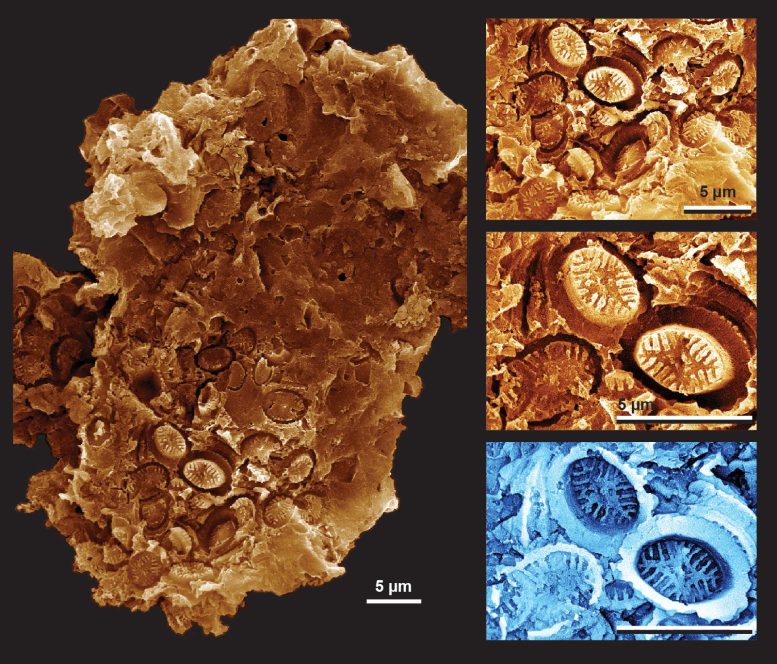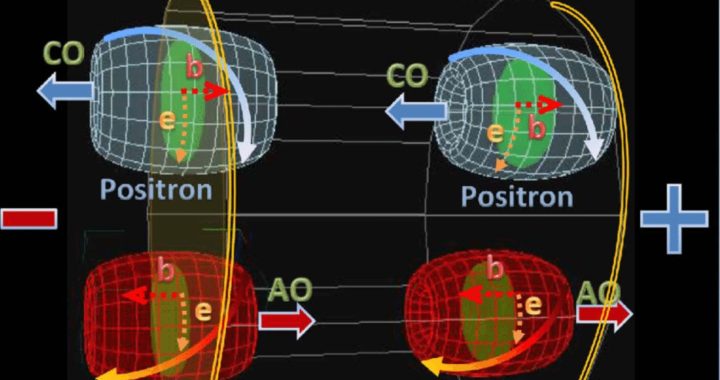Gli scienziati scoprono fossili “fantasma” – “completamente inaspettati”


Le immagini mostrano le impressioni di un rivestimento di parete cellulare collassato (cocosfera) sulla superficie di un frammento di materia organica antica (a sinistra) con singole placche ingrandite (sciroppi) per mostrare la notevole conservazione delle strutture a scala submicronica (a destra). L’immagine blu è invertita per dare un’immagine fossile virtuale, cioè per mostrare la forma 3D originale. Le piastre originali sono state rimosse dal sedimento per dissoluzione, lasciando solo tracce di fantasmi. Credito: SM Slater, P. Bowen/Science Journal
Un team internazionale di ricercatori ha scoperto un nuovo tipo di fossilizzazione.
La scoperta di fossili “fantasma” rivela la resilienza del plancton di fronte ai passati eventi di riscaldamento globale.
Un team internazionale di scienziati dell’University College London (UCL), del Museo Svedese di Storia Naturale, del Museo di Storia Naturale (Londra) e dell’Università di Firenze ha scoperto un notevole tipo di fossilizzazione che è rimasto praticamente inosservato fino ad ora.
I fossili sono impronte microscopiche, o “fantasmi”, di plancton unicellulare, chiamato coccolitofori, che visse nei mari milioni di anni fa, e la loro scoperta ha rivoluzionato la nostra comprensione di come il cambiamento climatico influenzi il plancton negli oceani.

Nano-fossile fantasma delle rocce giurassiche nello Yorkshire, Regno Unito. Credito: SM Slater et al.
I coccolitofori sono importanti negli oceani di oggi, forniscono gran parte dell’ossigeno che respiriamo, supportano le reti alimentari marine e intrappolano il carbonio nei sedimenti del fondo marino. Sono un tipo di plancton microscopico che circonda le loro cellule con lastre di calcare duro, chiamate coccoliti, che sono quelle che di solito si decompongono nelle rocce.
La diminuzione dell’abbondanza di questi fossili è stata documentata da diversi eventi pre-riscaldamento globale, indicando che questi plancton sono stati gravemente colpiti dai cambiamenti climatici e dall’acidificazione degli oceani. Tuttavia, uno studio è stato pubblicato oggi sulla rivista Scienza Presenta nuovi record mondiali per gli abbondanti fossili di fantasmi di tre[{” attribute=””>Jurassic and Cretaceous warming events (94, 120, and 183 million years ago), suggesting that coccolithophores were more resilient to past climate change than was previously thought.

The individual plates are coccoliths. Credit: Images from Nannotax https://www.mikrotax.org/Nannotax3/
“The discovery of these beautiful ghost fossils was completely unexpected,” says Dr. Sam Slater from the Swedish Museum of Natural History. “We initially found them preserved on the surfaces of fossilized pollen, and it quickly became apparent that they were abundant during intervals where normal coccolithophore fossils were rare or absent – this was a total surprise!”
Despite their microscopic size, coccolithophores can be hugely abundant in the present ocean, being visible from space as cloud-like blooms. After death, their calcareous exoskeletons sink to the seafloor, accumulating in vast numbers, and forming rocks such as chalk.

The fossils are approximately 5 µm in length, 15 times narrower than the width of a human hair. Credit: S.M. Slater, P. Bown et al. / Science journal
“The preservation of these ghost nannofossils is truly remarkable,” says Professor Paul Bown (UCL). “The ghost fossils are extremely small ‒ their length is approximately five-thousandths of a millimeter, 15 times narrower than the width of a human hair! ‒ but the detail of the original plates is still perfectly visible, pressed into the surfaces of ancient organic matter, even though the plates themselves have dissolved away.”
The ghost fossils formed while the sediments at the seafloor were being buried and turned into rock. As more mud was gradually deposited on top, the resulting pressure squashed the coccolith plates and other organic remains together, and the hard coccoliths were pressed into the surfaces of pollen, spores, and other soft organic matter. Later, acidic waters within spaces in the rock dissolved away the coccoliths, leaving behind just their impressions – the ghosts.

Ghost nannofossils were found in rocks from global warming intervals where normal coccolithophore fossils were rare or absent. Credit: S.M. Slater, P. Bown, et al. / Science journal
“Normally, paleontologists only search for the fossil coccoliths themselves, and if they don’t find any then they often assume that these ancient plankton communities collapsed,” explains Professor Vivi Vajda (Swedish Museum of Natural History). “These ghost fossils show us that sometimes the fossil record plays tricks on us and there are other ways that these calcareous nannoplankton may be preserved, which need to be taken into account when trying to understand responses to past climate change.”
Professor Silvia Danise (University of Florence) says: “Ghost nannofossils are likely common in the fossil record, but they have been overlooked due to their tiny size and cryptic mode of preservation. We think that this peculiar type of fossilization will be useful in the future, particularly when studying geological intervals where the original coccoliths are missing from the fossil record.”

Ghost nannofossils were found globally, in rocks from three rapid warming events in Earth’s history (the T-OAE, OAE1a, and OAE2). Credit: S.M. Slater et al.
The study focused on the Toarcian Oceanic Anoxic Event (T-OAE), an interval of rapid global warming in the Early Jurassic (183 million years ago), caused by an increase in CO2-levels in the atmosphere from massive volcanism in the Southern Hemisphere. The researchers found ghost nannofossils associated with the T-OAE from the UK, Germany, Japan, and New Zealand, but also from two similar global warming events in the Cretaceous: Oceanic Anoxic Event 1a (120 million years ago) from Sweden, and Oceanic Anoxic Event 2 (94 million years ago) from Italy.
“The ghost fossils show that nannoplankton were abundant, diverse, and thriving during past warming events in the Jurassic and Cretaceous, where previous records have assumed that plankton collapsed due to ocean acidification,” explains Professor Richard Twitchett (Natural History Museum, London). “These fossils are rewriting our understanding of how the calcareous nannoplankton respond to warming events.”
Finally, Dr. Sam Slater explains: “Our study shows that algal plankton were abundant during these past warming events and contributed to the expansion of marine dead zones, where seafloor oxygen-levels were too low for most species to survive. These conditions, with plankton blooms and dead zones, may become more widespread across our globally warming oceans.”
Reference: “Global record of “ghost” nannofossils reveals plankton resilience to high CO2 and warming” by Sam M. Slater, Paul Bown, Richard J. Twitchett, Silvia Danise and Vivi Vajda, 19 May 2022, Science.
DOI: 10.1126/science.abm7330






